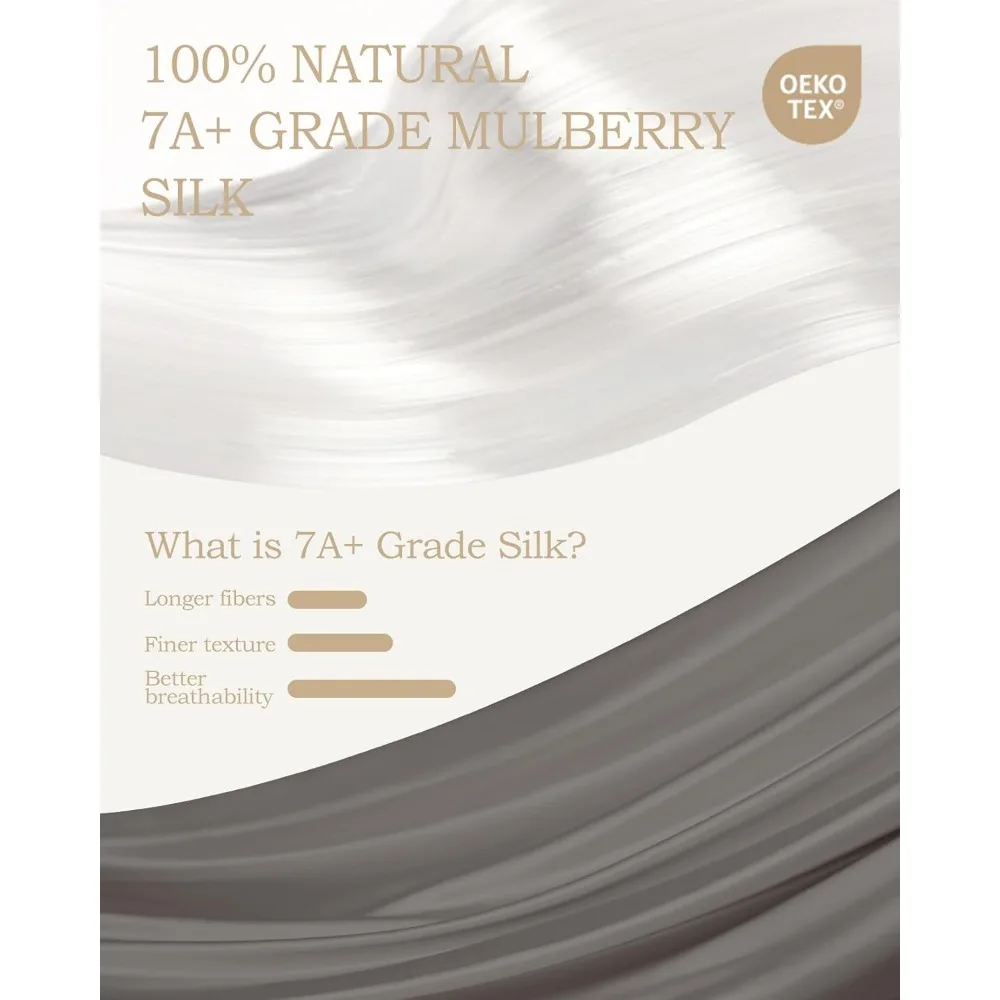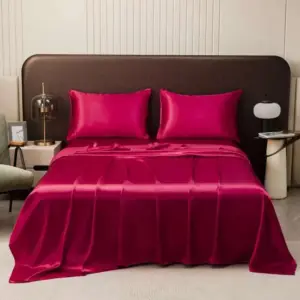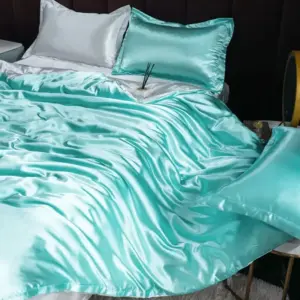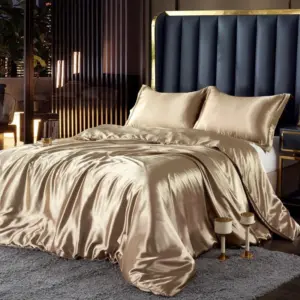Introduction: The Transformative Power of Silk in Bedroom Design
Silk linens transform an ordinary bedroom into an extraordinary sanctuary. Unlike any other fabric, silk combines unmatched softness with a distinctive sheen that instantly elevates any space it inhabits. The moment silk drapes across your bed, it creates a visual focal point that speaks of luxury and careful design consideration.
What makes silk truly exceptional is its multisensory appeal – the cool, smooth texture against your skin, the gentle shimmer as light plays across its surface, and the way it seems to flow like liquid when arranged. These qualities have made silk treasured for thousands of years, dating back to ancient civilizations that recognized its exceptional properties.
Among all varieties, Mulberry silk benefits make it the premium choice for bedding. It’s remarkably 22% smoother than cotton, providing both aesthetic beauty and tangible comfort. In the following sections, we’ll explore various design approaches that leverage silk’s unique properties – from minimalist modern to classical luxury and nature-inspired designs – showing how this remarkable fabric can become the foundation of your bedroom sanctuary.
The Visual Impact of Silk in Bedroom Design
Silk possesses visual qualities that no other bedding material can match. The natural protein fibers in Mulberry silk bed sheets create a distinctive luminosity that reflects light in a way that’s both subtle and captivating. This natural sheen can reflect up to 30% more light than cotton fabrics, creating a dimensional glow that transforms with changing light throughout the day.
Morning sunlight brings out silk’s brilliant highlights, while evening lamplight creates a warm, intimate ambiance as the fabric captures and diffuses the glow. This interplay between silk and light makes it an active design element rather than merely a functional bedding choice.
The way silk drapes also contributes significantly to visual softness in a bedroom. Its natural flow creates gentle curves and shadows that soften the overall look of the space. Even in rooms with predominantly straight lines and hard surfaces, silk introduces an element of graceful movement and organic shape.
Perhaps most remarkably, silk’s visual depth can make a space appear more expansive and elegant. The way it catches light creates visual interest that draws the eye, while its luxurious appearance elevates the perceived value of the entire room – transforming even modest spaces into sophisticated retreats.
Design Theme 1: Modern Minimalist Elegance with Silk
Silk adds a touch of luxury to minimalist bedrooms without compromising their clean, uncluttered aesthetic. The key is selecting the right silk elements that enhance rather than overwhelm the space’s simplicity.
For a modern minimalist approach with silk:
- Choose a restrained color palette featuring white silk sheets or other neutral tones like ivory, pale gray, or subtle blush. These colors maintain visual simplicity while showcasing silk’s natural luster.
- Pair with furniture featuring clean lines and minimal ornamentation – natural wood platform beds, simple nightstands, and brushed metal accents work particularly well.
- Layer different silk textures thoughtfully – combine a matte silk duvet cover with shinier silk pillowcases to create subtle textural contrast without visual chaos.
- Use silk pillowcases and throws as focal points against more subdued bedding elements, allowing these pieces to become statement elements through their natural sheen.
- Consider lighter-weight silk (19-21 momme) for more fluid drape that maintains the airy, uncluttered feel essential to minimalist design.
The beauty of this approach lies in silk’s ability to add luxury through inherent quality rather than ornate details. A minimalist silk bedroom feels both sophisticated and calming – the perfect combination for a modern sanctuary that soothes through simplicity while still feeling special.
Design Theme 2: Classical Luxury with Rich Silk Textiles
Classical luxury design embraces silk’s most opulent qualities, creating spaces that feel timeless and indulgent. This approach celebrates rich textures and deeper colors that showcase silk’s heritage as a fabric of royalty and refinement.
For a classically luxurious silk bedroom:
- Select deeply colored luxury silk bedding sets in jewel tones like burgundy, navy, or emerald that highlight silk’s exceptional depth of color and rich sheen.
- Pair silk with complementary luxurious textures like velvet pillows or brocade accents that create a multi-layered sense of opulence.
- Choose furniture with traditional silhouettes – carved wooden headboards, nightstands with classic details, and antique brass hardware complement silk’s elegance.
- Incorporate patterned silk elements such as damask or jacquard throws that add visual interest through texture rather than busy prints.
- Frame the bed with silk drapery panels that puddle slightly on the floor for dramatic effect and traditional luxury.
- For canopy or four-poster beds, consider silk panels that create a sense of enclosure and intimacy.
In classical luxury settings, opt for higher momme weights (22-25) that provide substantial drape and more pronounced luster. These heavier silk varieties hang more dramatically and convey the substance expected in traditional luxury settings.
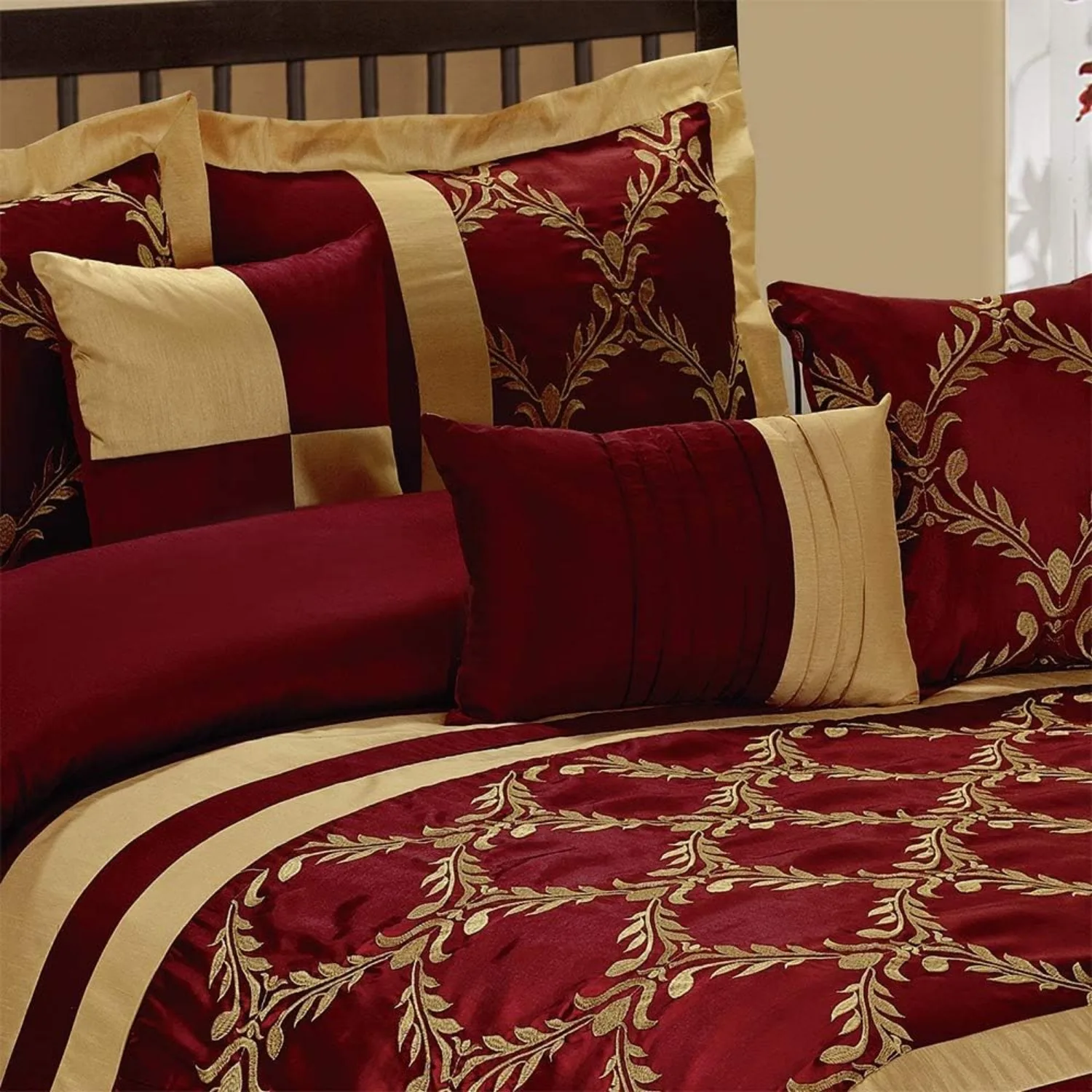
Design Theme 3: Nature-Inspired Tranquility with Silk Accents
Nature-inspired bedroom design harnesses silk’s organic origins to create serene spaces that connect with the natural world. This approach combines silk’s luxurious properties with earthy elements for balanced, restorative environments.
For a nature-inspired silk sanctuary:
- Select green silk sheets or other earth-toned silk bedding in sage, sky blue, soft terracotta, or gentle lavender to evoke natural landscapes.
- Blend silk with other natural materials like linen throw blankets, cotton accent pillows, and wooden furniture with visible grain patterns.
- Incorporate botanical elements through both live plants and botanical prints that complement silk’s organic sheen.
- Emphasize biophilic design principles by positioning the bed to maximize natural light and views of outdoor spaces where possible.
- Layer different natural textures – rough woven baskets, smooth ceramics, and tactile woods – with silk as the luxury highlight that elevates these simpler elements.
Scientific research confirms that nature-inspired colors improve sleep quality, making this approach both beautiful and functional. Consider plants like snake plant, pothos, or peace lily that thrive in bedroom environments and whose leafy textures create pleasing contrast with silk’s smooth surface.
This design theme creates a middle ground between minimalism and traditional opulence, focusing on creating a grounded space that still feels special through silk’s natural luxury.
Mastering the Art of Silk Layering in Bed Design
Creating a luxurious bed with silk involves thoughtful layering that maximizes both visual impact and comfort. Proper layering transforms a simple bed into a multi-dimensional focal point while enhancing silk’s practical benefits.
Start with foundation layers: a silk fitted sheet creates the initial touchpoint for comfort. This base layer makes the most of silk’s skin-friendly properties and provides temperature regulation that maintains conditions within 3-5°F of ideal sleeping temperature.
Build middle layers by combining silk sheets and duvets with complementary fabrics. For example, pair a silk flat sheet with a lightweight cotton blanket, then add a silk duvet cover for a balance of textures that remain harmonious.
For top layers, strategically place decorative elements:
- Position larger Euro shams at the back against the headboard (silk or complementary fabric)
- Arrange standard sleeping pillows in silk pillowcases
- Add 2-3 decorative silk pillows in varying sizes and possibly textures
- Finish with a silk throw blanket placed at the foot of the bed or draped across a corner
Adjust your approach seasonally – in summer, reduce layers and use lighter-weight silk elements, while winter calls for more substantial silk layers possibly combined with warmer materials like cashmere or wool.
Color layering creates additional dimension. Consider tonal approaches (varying shades of the same color), contrasting schemes (complementary colors that highlight silk’s vibrancy), or accent methods (neutral base with targeted silk color elements).
Strategic Color Selection for Silk Bedroom Elements
Color choice dramatically impacts how silk functions in your bedroom design. Beyond mere preference, color selection for silk bedding affects both aesthetics and psychological comfort.
The psychology of color takes on special significance with silk fabrics due to their enhanced light reflection. Blues in silk bedding promote measurable tranquility, potentially reducing heart rate by up to 12%, making them excellent choices for primary sleep surfaces. Neutral tones like ivory, champagne, and pale gray showcase silk’s natural sheen without competing color saturation.
When choosing perfect silk bed linen colors, consider these approaches:
- Monochromatic schemes work exceptionally well with silk because its varying light reflection creates natural dimension even within a single color family
- For contrast techniques, use silk as the highlight element – a charcoal room with silver silk bedding creates dramatic impact
- Seasonal adjustments can be made through accent pieces rather than replacing all silk elements – winter might incorporate deeper jewel tones while summer embraces lighter pastels
Remember that silk’s unique light reflection affects how colors appear. Colors look richer and more dimensional in silk than in flatter fabrics, so even subtle hues make significant impact. Sample silk swatches in your actual bedroom lighting before committing to full bedding sets.
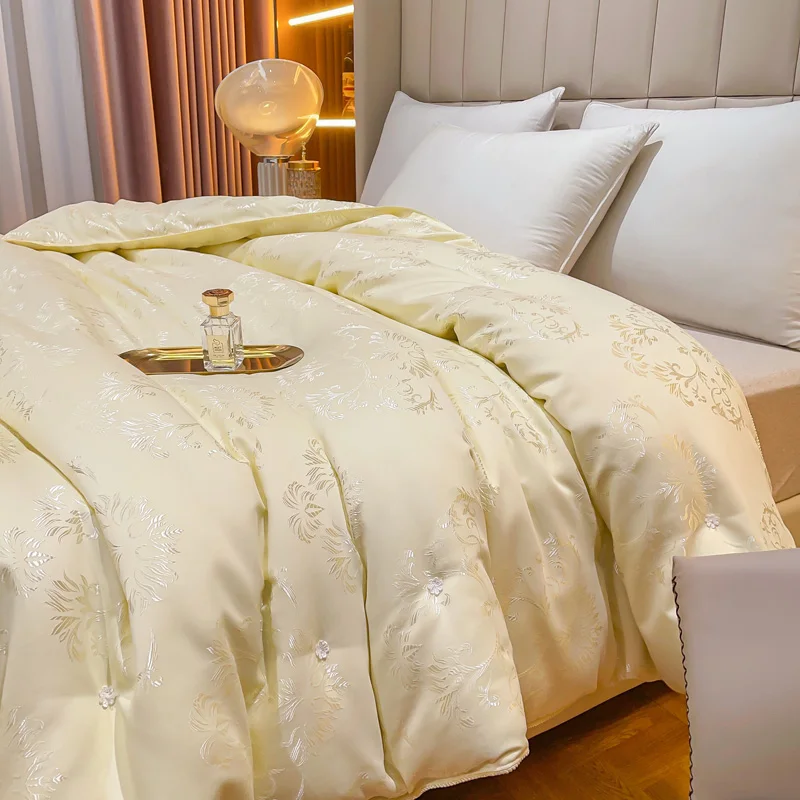
Lighting Considerations to Enhance Silk’s Natural Beauty
The right lighting dramatically enhances silk’s natural beauty in bedroom design. Understanding how different light sources interact with silk helps maximize its visual impact throughout the day and night.
Natural daylight brings out silk’s subtle color variations and highlights its natural sheen. Position your bed where morning light can gently illuminate silk surfaces without harsh direct exposure that might damage the fabric over time.
For artificial lighting, warm light sources between 2700K-3000K complement silk’s natural luminosity best. Cool white lights can flatten silk’s dimensional qualities and fail to showcase its rich texture. Consider installing dimmer switches to adjust light intensity according to mood and time of day.
Strategic light placement matters significantly with silk bedding. Lighting positioned at 45-degree angles rather than directly overhead maximizes silk’s natural luster by creating gentle highlights and shadows across textured surfaces. Bedside lamps with diffused shades create an intimate evening ambiance that highlights silk’s reflective qualities.
Smart lighting options can enhance the silk experience further, allowing programmed transitions that highlight different aspects of your silk bedding throughout the day and evening. Gentle evening lighting that gradually dims can work in concert with silk’s soothing properties to create the perfect pre-sleep environment.
Full-size Silk Sheets, King Size Silk Sheets, Queen Size Silk Sheets, Twin Size Silk Sheets, Washable Silk Sheets
Price range: $95.95 through $178.37 Select options This product has multiple variants. The options may be chosen on the product page100% Silk Sheets, Green Silk Sheets, King Size Silk Bedding Set, Mulberry Silk Bedding Sets, Queen Size Silk Bedding Set
Price range: $1,246.21 through $1,615.22 Select options This product has multiple variants. The options may be chosen on the product page100% Silk Sheets, King Size Silk Bedding Set, Mulberry Silk Bedding Sets, Queen Size Silk Bedding Set, White Silk Sheets
Price range: $1,000.79 through $1,351.42 Select options This product has multiple variants. The options may be chosen on the product pageLuxury Silk Bedding Sets, Mulberry Silk Bedding Sets, Silk Sheet and Pillowcase Set
Price range: $61.33 through $159.87 Select options This product has multiple variants. The options may be chosen on the product page100% Silk Sheets, Luxury Silk Bedding Sets
Price range: $1,151.50 through $1,221.50 Select options This product has multiple variants. The options may be chosen on the product pageKing Size Silk Bedding Set, Luxury Silk Bedding Sets, Queen Size Silk Bedding Set, Twin Silk Bedding Set
Price range: $123.42 through $270.22 Select options This product has multiple variants. The options may be chosen on the product page
The Unmatched Benefits of Silk Linens for Sleep Quality
Beyond its visual appeal, silk bedding provides functional benefits that significantly enhance sleep quality, making it as practical as it is beautiful.
Silk’s natural temperature-regulating properties create ideal sleeping conditions year-round. Unlike synthetic or cotton bedding that can trap heat, silk actively helps transform sleep quality by:
- Maintaining skin temperature within 3°F of optimal sleeping conditions
- Wicking moisture away from the body (absorbing up to 30% of its weight without feeling wet)
- Creating natural ventilation through its protein fiber structure
- Providing light insulation in winter without overheating
The hypoallergenic qualities of silk benefit sensitive sleepers. Its natural proteins resist dust mites, mold, and other common allergens that can disrupt sleep. The tight weave creates a natural barrier against these irritants while still allowing skin to breathe.
For beauty sleep enthusiasts, silk’s smooth surface reduces friction against skin and hair by 43% compared to cotton. This means fewer facial creases and less hair breakage during sleep, extending the benefits of your skincare and hair care routines.
These functional advantages make silk bedding an investment in both your bedroom’s appearance and your personal wellbeing – a rare combination of luxury that actually improves daily life through better rest.
Choosing the Perfect Silk for Your Bedroom Design
Selecting the right silk quality ensures your bedroom design achieves both the aesthetic and functional benefits this luxury fabric offers.
Understanding what makes Mulberry silk special helps inform your selection. Mulberry silk, produced by silkworms fed exclusively on mulberry leaves, creates exceptionally smooth, strong, and consistent fibers. This translates to more uniform appearance, better durability, and superior feel compared to other silk varieties like wild silk or tussah.
Momme weight, silk’s measure of density, significantly impacts both appearance and performance:
* 19-21 momme: Lighter, more fluid drape ideal for summer use and minimalist designs
* 22-25 momme: Balanced weight offering durability with luxurious drape, perfect for year-round use
* 25+ momme: Substantial, premium feel with maximum durability and pronounced luster
When assessing silk quality, look for these indicators:
* Even coloration without splotchy areas
* Smooth, consistent texture without slubs (unless intentionally textured)
* Proper certification from recognized textile authorities
* Clear labeling of momme weight and silk type
Pure silk delivers the full range of benefits, while silk blends (often mixed with cotton or synthetic fibers) may offer easier care at the expense of some luxury properties. For primary bedding elements like sheets and duvet covers, pure silk provides the most dramatic design impact and comfort benefits.
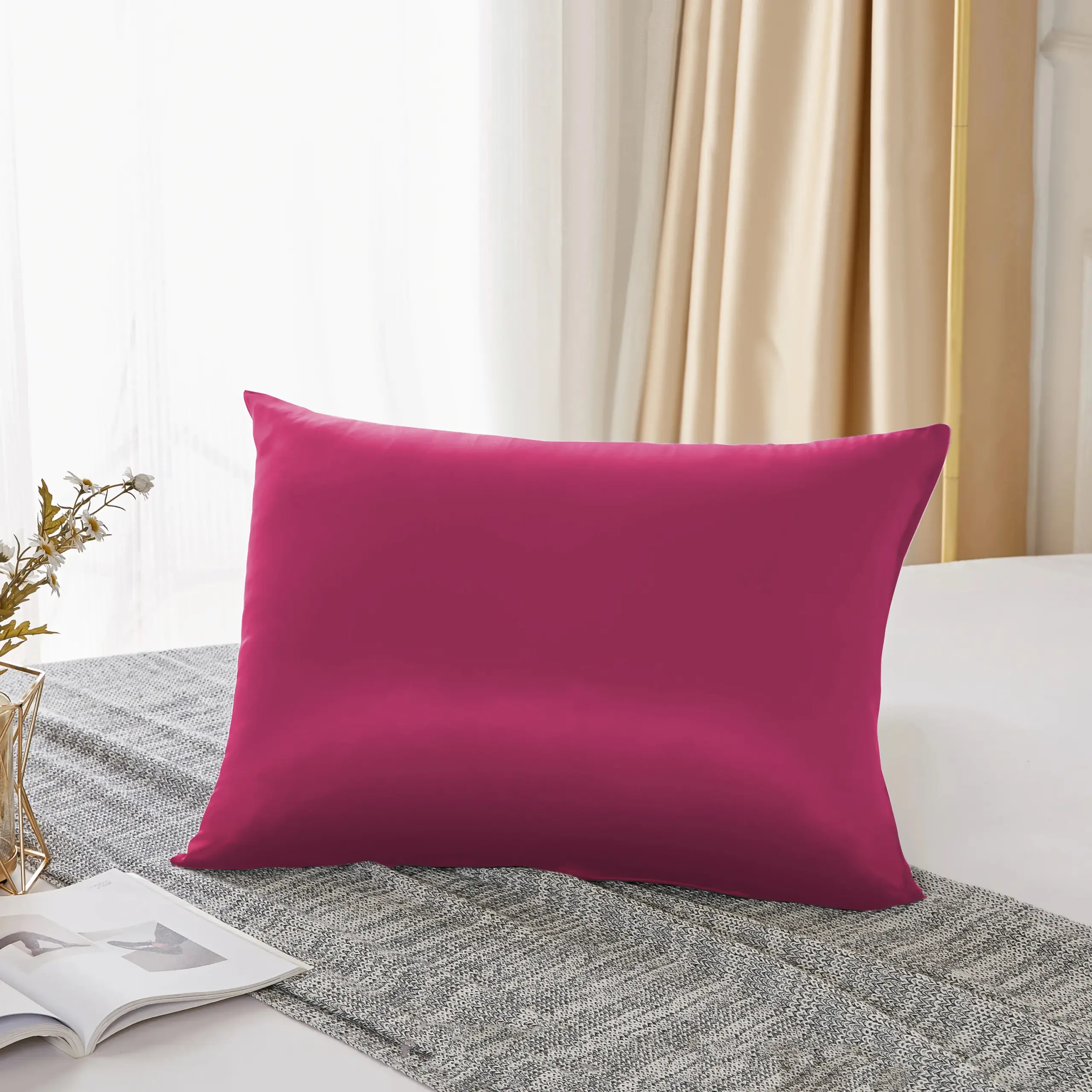
Essential Silk Care for Lasting Bedroom Luxury
Proper silk care preserves both the beauty and functionality of your bedroom design investment. While silk has a reputation for delicacy, following simple care routines ensures it remains beautiful for many years.
Washing: Hand wash silk in cold water using mild, silk-specific detergent or choose washable silk sheets specifically designed for machine washing. Always use gentle cycle and place items in mesh laundry bags.
Drying: Never wring silk – instead, gently press water out with towels. Avoid direct sunlight when air-drying, and never use machine dryers unless specifically indicated for washable silk varieties.
Storage: Store silk items breathably – avoid plastic bags which can trap moisture. Acid-free tissue paper helps prevent creasing during extended storage.
Wrinkle treatment: Use a steamer rather than iron for removing wrinkles. If ironing is necessary, use the lowest silk setting with a pressing cloth between the iron and fabric.
Stain management: Address spills immediately by blotting (never rubbing) with cold water and mild soap if needed.
With proper care, quality silk bedding can last 15+ years – far longer than conventional bedding materials. This longevity makes silk not just a luxury choice but also a practical investment in bedroom design that maintains its beauty over time.
How to Complement Silk Bedding with Other Bedroom Elements
Creating a cohesive bedroom design requires thoughtful coordination between silk bedding and other room elements. The right complementary choices enhance silk’s luxury while creating visual balance.
Wall colors that enhance silk’s appearance include soft neutrals (warm whites, pale grays, gentle taupes) that allow silk’s sheen to stand out. For more dramatic settings, deeper hues like navy, charcoal, or forest green create stunning contrast with lighter silk tones.
When styling silk sheets in your bedroom, select furniture that provides appropriate contrast to silk’s softness:
* Natural wood pieces with visible grain add organic warmth
* Painted furniture in complementary tones creates cohesion
* Metal elements (brass, gold, chrome) catch light in ways that echo silk’s reflective properties
Floor treatments should balance silk’s luxury – plush area rugs in natural fibers provide textural contrast while maintaining the quality feel. For window treatments, consider fabrics with similar drape characteristics to create visual continuity.
Artwork and decor should complement rather than compete with silk bedding. Black and white photography, abstract art in complementary colors, or natural elements like crystal or stone all pair beautifully with silk’s refined appearance.
For optimal visual impact, aim for approximately 30% silk elements in your overall design – enough to establish luxury but not so much that the special quality of silk becomes overwhelming.
Frequently Asked Questions About Designing with Silk Linens
Is silk bedding practical for everyday use?
Yes, quality silk bedding is surprisingly durable when properly cared for. Modern manufacturing techniques and proper care routines mean silk can withstand regular use while maintaining its beauty.
How does silk compare to satin for bedroom design?
While similar in appearance, silk is a natural protein fiber with temperature-regulating and hypoallergenic properties that synthetic satin lacks. Silk provides superior breathability, moisture management, and a more authentic luster that enhances bedroom design.
Is silk bedding only suitable for warm climates?
No, silk’s natural temperature regulation makes it ideal for all climates. It helps cool in summer by wicking moisture away from the body, while providing light insulation in winter.
How do I prevent silk sheets from sliding off the bed?
Choose fitted sheets with deep pockets and elastic all around rather than just at corners. For flat sheets and duvet covers, select slightly textured silk rather than the smoothest charmeuse varieties.
Is silk worth the higher cost compared to other bedding?
When considering cost-per-use, quality silk bedding often proves economical. With proper care, silk bedding lasts up to three times longer than cotton equivalents, while providing superior comfort and maintaining its appearance.
How environmentally friendly is silk bedding?
Silk is biodegradable and requires fewer chemical processes than many synthetic alternatives. Look for peace silk or Ahimsa silk options if ethical production concerns are important to you.
Creating Your Unique Silk Sanctuary: Personalization Tips
Transforming design inspiration into your personal silk sanctuary requires thoughtful customization that reflects your individual preferences while maintaining silk’s inherent luxury.
Start by identifying bedroom color schemes with silk that resonate with your personal style – whether you’re drawn to serene neutrals, bold jewel tones, or soft pastels. Your color foundation establishes the emotional tone of your space.
Incorporate personal elements that complement silk’s luxury – family heirlooms, artisanal pieces, or meaningful art create spaces that feel authentically yours while maintaining design cohesion. Personal items with textural contrast (like handcrafted ceramics or wooden mementos) create particularly pleasing juxtaposition with silk’s smoothness.
Consider seasonal adaptability without complete redesigns. Core silk pieces in neutral tones can be accessorized differently throughout the year – summer might feature lightweight throws and botanical elements, while winter introduces warmer accent colors and additional textural layers.
Balance trendy elements with silk’s timeless appeal. While silk itself transcends trends, you can incorporate current design movements through easily changed accessories and accent pieces that complement your foundation silk elements.
Expert Insights: Designers’ Perspectives on Silk in Bedroom Design
Interior designers consistently highlight silk’s unmatched ability to elevate bedroom spaces through both visual and tactile luxury. Professional designers strategically use silk as a statement element that anchors the room’s overall aesthetic.
Designers recommend focusing on quality over quantity when incorporating silk. A few premium silk elements make more impact than numerous lesser-quality pieces. This targeted approach allows silk to serve as the room’s luxury highlight without overwhelming the space.
Current trends in luxury design feature silk in unexpected applications beyond traditional bedding – silk-upholstered headboards, wall panels with silk insets, and even silk-wrapped lighting fixtures extend silk’s presence throughout the bedroom in sophisticated ways.
Professional designers excel at mixing silk with other premium materials for textural depth. The juxtaposition of rough and smooth textures – like pairing silk bedding with nubby wool throws or raw wood furniture – creates multidimensional spaces that engage the senses.
For smaller spaces, designers recommend light-colored silk with subtle sheen rather than high-gloss varieties, creating luxury that enhances rather than overwhelms limited square footage. This approach maintains silk’s special quality while ensuring the space feels open and inviting.

